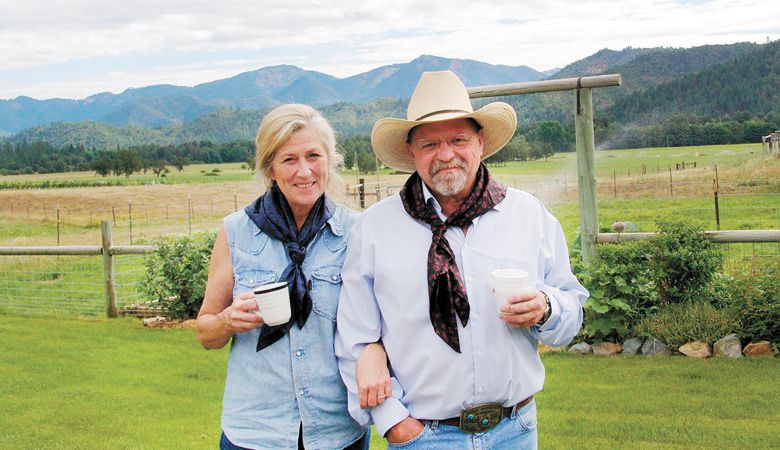Mon Doozy
Plaisance Ranch dials up Savoie flair
I expected to find cattle, warm sunshine and Steve “The Joker” Miller’s old house while exploring Williams, Oregon. I did not expect to find Mondeuse.
Years ago, a friend gave me my first bottle of Mondeuse from France’s Savoie region. The wine was all dark fruit and pepper, with chewy tannins, brisk acidity and a bitter almond note I usually associate with Italian Dolcetto. It was love at first sip.
But what is a grape from the French Alps doing in decidedly non-alpine Williams?
The Mondeuse from Williams is made by Joe Ginet of Plaisance Ranch. It is a tribute to his grandfather, Joseph Ginet, who planted his own Mondeuse vines southwest of Jacksonville in the early 1900s.
Ginet’s grandfather grew up in Saint-Jean-Pied-de-Port, a tiny village in Savoie. After resigning from the French military in 1890, Joseph Ginet made his way to New York City’s Ellis Island in search of opportunity. Lured by news of gold and cheap land, he earned his way cross-country by working as a railway cook.
In 1898, Joseph Ginet settled in Southern Oregon, where he purchased 500 acres near the mining town of Buncom. Ginet salvaged an old orchard on his property and made a living by selling fruit and plants under the business name “Plaisance Orchard.”
A few years later, he returned from a trip to Savoie with enough Mondeuse starts to plant a small vineyard on his property in 1905. These are probably the first Mondeuse vines planted in Oregon. If anyone has a counter-claim, it should be pointed out that American nurseries back then were frequently mistaking Refosco dal Peduncolo Rosso for Mondeuse.

While his grandfather did make wine, Joe Ginet says Prohibition likely deterred him from selling any. Selling only fruit didn’t turn out to be enough. Like so many other hard-working farmers, Joseph Ginet’s family lost their ranch during the Great Depression. Ginet’s Mondeuse vines managed to survive until the four-legged residents of an elk farm destroyed them in 1974.
Joe and his wife, Suzi, purchased properties in Williams to start Plaisance Ranch in 1979 and 1983. In 1998, with the help of cousins visiting from Savoie, the Ginets began the transition from dairy cows to grapevines. The fact the cousins also happen to be vineyard owners and vine-grafting consultants was a bonus.
In 2000, Ginet visited Savoie and, like his grandfather, brought back Mondeuse sticks. The Mondeuse 386 clone he selected is described in French grape catalogs as well-suited to producing age-worthy wines. Ginet says he is the only winery in America with this particular clone.
Ginet’s acre of Mondeuse is producing enough fruit to make, on average, four barrels of wine a year. The 2021 vintage was an outlier at seven barrels. After the quarantine process and a few years of using it in a blend, Ginet made his first 100% Mondeuse wine in 2010.
I asked Ginet whether Mondeuse grapes are well-suited to the warmer Southern Oregon climate. I was concerned about overly ripe grapes leading to “goopy” wines. He quickly pointed out his grandfather’s letters to friends and family often mentioning how the Applegate Valley reminded him of farming in Savoie.
That was then. I decided to look up the current temperature data for Williams and Saint-Jean-Pied-de-Port. As expected, Williams is 7°F warmer on average from June through early October. The overnight lows, however, appear similar.
The warmer days aren’t a problem for Ginet’s Mondeuse grapes. “It’s an early ripener, and 23 Brix is as high as it gets. Some years it’s only 20 Brix, and I need to chaptalize,” Ginet says. The 2018 Plaisance Ranch Mondeuse ($35) is 12.3% alcohol by volume, which is right in my wheelhouse.
The wine’s color appears somewhere between crushed blackberries and red-violet crayons melted on a summer sidewalk. It also has the tiniest cranberry-colored rim.
Blackberries reappear on the nose, joined by a fresh citrus scent that took time to decipher. I finally decided it’s the smell of damp laundry hanging on a clothesline after being washed with Mrs. Meyer’s lemon verbena laundry detergent. Notes of pencil shavings and sage hover in the background.
The palate is a heady combination of elevated acidity and the kind of tannins that make a tongue feel like its roof is made of brown corduroy. Deep, dark fruit flavors join forces with fresh-cracked pepper, beeswax and the bitter note I was hoping for. With each sip I could hear Bob Weir singing, “Too much of everything is just enough.”
Here’s some more good news: In 2020, Ginet planted Persan, a super-rare Savoie grape renowned for making age-worthy red wines. I can’t wait to return to the Savoie fair in Williams.
ABOUT THIS COLUMN: The Changeup is a baseball pitch designed to disorient and confuse, the perfect representation of the unknown and its mastery over those who think they know what to expect. This column is devoted to those unorthodox Oregon wines you never saw coming.











